December 6, GAZA (Reuters) – After entering the center of Khan Younis on Wednesday, Israeli forces engaged Hamas in heavy fighting in the southern Gaza region, driving Palestinian people to flee to other locations as the number of safe havens shrank.
During one of the fiercest fighting episodes in the two months since Israel started its military effort to eradicate the Palestinian group, Israeli airplanes also bombarded sites along the heavily populated coastal area.
Hospitals in Palestine were bursting at the seams with wounded and dead, many of them women and children, and supplies were running low, according to Palestinian physicians. There were only a few locations in the south that Israel had declared safe for the hundreds of thousands of displaced persons who had been forced from the north.
The head of the UN human rights office in Geneva described the scenario as “apocalyptic” and warned that both sides would violate people’s rights gravely. Aid could not be delivered from Egypt across the Rafah border crossing, according to the UN.
Scenes from the street battles pic.twitter.com/wsDqXeoNhw
— Gaza Report – اخبار غزة (@gaza_report) December 6, 2023
Following the breakdown of the seven-day truce last week, Israeli troops and tanks advanced southward and encircled Khan Younis after regaining most of the authority over northern Gaza.
Israel said that its forces had hit hundreds of targets, one of which was a resistance cell close to a northern school. The al-Qassam Brigades, the armed wing of Hamas, claimed that fighting was fierce.
North and east of Khan Younis, residents reported, tanks were engaged in combat with Palestinian rebels while Israeli bombing escalated overnight, resulting in civilian casualties.
Some Palestinians recounted fortunate escapes following the destruction of their homes during a nocturnal airstrike on Khan Younis’ al-Amal neighborhood.
“I swear we don’t even know how we made it out alive,” stated Hamdi Tanira, recounting an assault on a home where he and perhaps thirty other people—20 of whom were children—were sleeping.
“We were sleeping soundly, not disturbing anyone,” stated Amal Mehdi, another witness. “All of a sudden, the bombardment hit us, you wouldn’t know where it came from, it was a miracle that we were pulled from under the rubble.”
According to locals and Hamas media, the Jabalia refugee camp in northern Gaza was bombarded by tanks, navy vessels, and fighter jets along with highways and residential buildings.
According to them, there were tanks positioned near Yehya Al-Sinwar, the commander of Hamas in Gaza,’s home, near the Khan Younis refugee camp. It was hard to tell who was there.
As the fighting shifted to close-quarters ground action, the Washington-based Institute for the Study of War reported that Hamas fighters were switching to anti-personnel mines and improvised explosive devices.
Israel launched its military assault in retaliation for an attack on October 7 by Hamas fighters who, according to Israel’s count, rampaged through Israeli cities, murdering 1,200 people and taking 240 prisoners.
At least 16,248 people, including 7,112 children and 4,885 women, have died in Gaza since then, according to a Tuesday statement from Hamas’ media office. The Gaza Health Ministry did not immediately confirm such numbers.
Israel claimed that since the ground assault started five weeks ago, 84 of its soldiers had died.
The few hospitals in Gaza that are still open are hardly operating. Volker Turk, the UN’s human rights commissioner, said reporters that his colleagues had called the conditions inside the enclave “apocalyptic.”
“In these circumstances, there is a heightened risk of atrocity crimes,” he said.
Khan Yunis, southern Gaza this morning after intense IDF strikes. pic.twitter.com/vMuvAPBz0p
— Clash Report (@clashreport) December 6, 2023
According to international treaties, crimes against humanity, war crimes, and genocide are all considered “atrocity crimes” by the UN.
Israeli humanitarian affairs officer Colonel Moshe Tetro claimed that the military has been employing phone calls, web announcements, and pamphlets to notify people ahead of time to leave areas of Khan Younis where it intends to conduct operations.
Although Hamas has disputed the accusations, the Israeli military claimed that the organization was blocking residents from fleeing to secure areas and was using them as human shields.
Gazans claim there is nowhere safe to go because Israel is hitting locations where it is directing Palestinians to go, and the few remaining cities and shelters are overrun.
Launch of Israeli Arrow long range air defence system interceptor missile towards a missile in the Red Sea from Eilat. pic.twitter.com/MTMgUKyzT8
— Clash Report (@clashreport) December 6, 2023
Those who have been displaced and are taking refuge close to the border claimed they would not travel because they were afraid Israel will try to force them into Egypt.
“This is our final destination; we won’t go if they try to deport us by force. One of the men who was sleeping rough with his friends remarked, “We would rather die in our place. Not even tents were with them.
Israel claims that it is working to locate and release the women and children who are still hostages in the hands of Hamas. More than 100 hostages were returned by Hamas during the ceasefire, leaving 138 prisoners behind.
Israel’s closest ally, the United States, has pushed Israel to take further action to lessen damage to civilians and permit the entry of gasoline and other supplies into Gaza.
According to UN representative Turk, a two-state solution involving an independent Palestine and an end to Israeli occupation of Palestinian territory was the only way to resolve the problem.
I am a dedicated student currently in my seventh semester, pursuing a degree in International Relations. Alongside my academic pursuits, I am actively engaged in the professional field as a content writer at the Rangeinn website.







